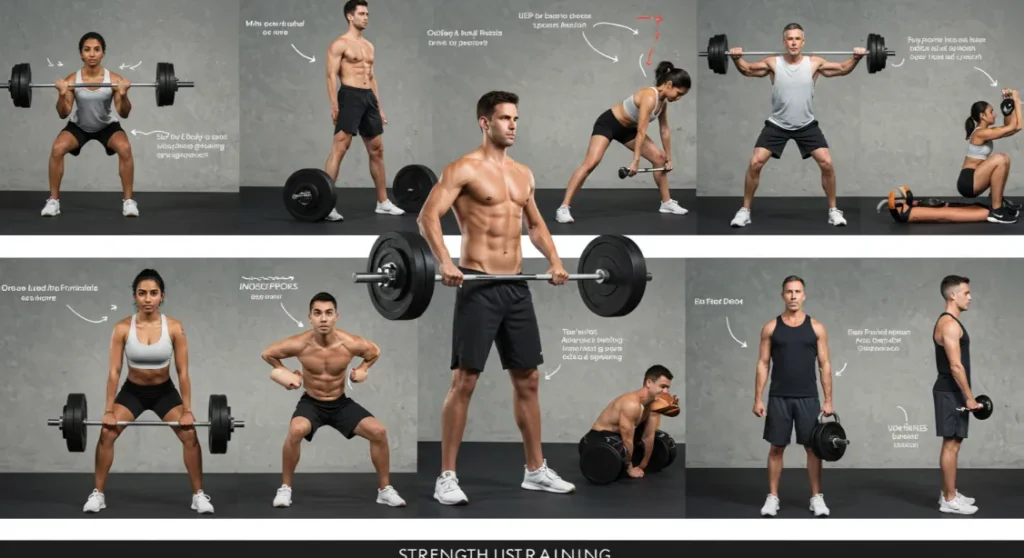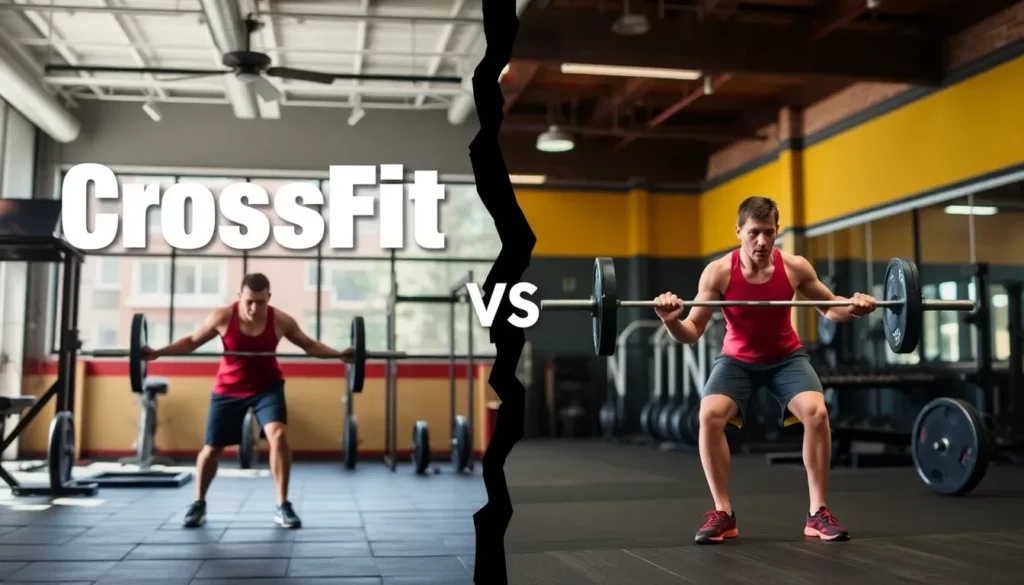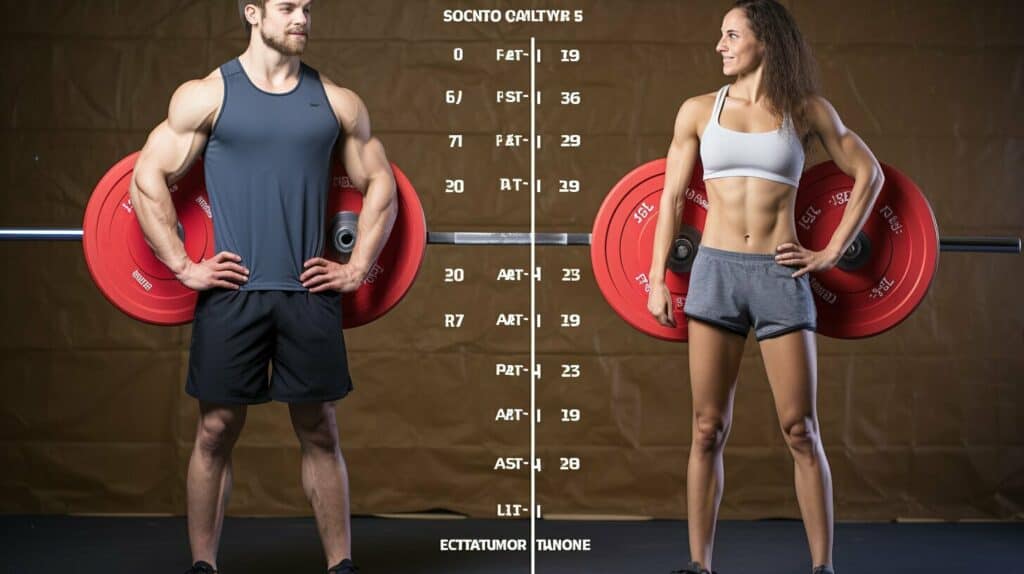Okay, let’s talk iron, sweat, and figuring out your fitness journey. You’re staring down two heavyweight contenders: CrossFit vs Weightlifting. What’s the real difference, and more importantly, which approach to fitness is right for you? Explore Calisthenics vs CrossFit for bodyweight alternatives.?
Here’s the dirt, straight up: CrossFit is like a fitness buffet – a wild mix of CrossFit workouts featuring strength training, cardio like aerobic exercises, and gymnastics, all thrown together in constantly varied workouts. The goal? Build all-around fitness and work capacity. Think being ready for anything physical challenges life throws your way. Weightlifting—whether it’s traditional weightlifting focused on building strength with moves like squats and presses, or competitive Olympic weightlifting mastering the snatch and clean & jerk—is about pure, focused strength development and technical mastery. [6, 7, 16]
CrossFit often gives you a bigger engine (cardiovascular fitness, better VO2 max), while Weightlifting typically builds more raw muscle strength and focused muscle mass. [2] Choosing depends on your fitness goals: broad, functional fitness (CrossFit) or specialized, maximum strength (Weightlifting).
Key Takeaways
- Engine vs. Chassis: CrossFit generally boosts endurance, aerobic fitness (VO2 max), and explosive power (like jumping) more. [2] Weightlifting excels at building sheer upper body muscle strength and targeted muscle mass (hypertrophy). [2, 6]
- CrossFit = Variety: Mixes weightlifting movements, gymnastics, and cardiovascular exercises in high-intensity workout formats designed for functional movements. [6, 16] Uses a wide range of equipment and exercises.
- Weightlifting = Focus: Centers on progressive overload (getting stronger over time) with structured training program design, often focusing on core compound movements or the two Olympic lifts. [6, 7] Great for strength gains.
- Ouch Factor: Common risk of injury spots in CrossFit studies include shoulders (from gymnastics/kipping), lower back (during heavy lifts), and hands/wrists. [4] Proper technique is crucial everywhere.
- Your Goal is King: Choose CrossFit for broad physical fitness; pick Weightlifting for peak strength development and mastering specific lifts. Hybrid workouts blending both are also popular. [9, 13]
- Muscle & Bone: Both forms of exercise help build muscle mass and improve bone density, key benefits of strength training. [6, 8]
Decoding the Disciplines: What’s Really Happening?
You see the videos, hear the grunts. But what defines these approaches to fitness?
CrossFit: The High-Intensity Melting Pot
Born in 2000, CrossFit took the fitness world by storm with its philosophy: “constantly varied, high-intensity, functional movements.” [16] Imagine a training style that borrows elements of strength training, cardio, and gymnastics, then mixes them up daily. [6] One day it’s sprints and pull-ups (body weight moves!), the next it’s heavy lifts like deadlifts, then maybe rowing or kettlebell swings. The aim isn’t necessarily to be the best at one thing, but to be highly competent across a broad spectrum of physical skills. [6, 7]
Workouts, known as WODs (Workout of the Day), happen in “boxes” – specialized gyms often fostering a strong communal atmosphere. [6, 9, 18] Sessions typically include a warm-up, skill work (proper technique focus!), the intense WOD (often timed or for max rounds – AMRAP), and a cool-down. [5] You’ll encounter a range of exercises from barbell exercises and box jumps to rope climbs and running. It’s designed to improve your readiness for everyday life and unexpected physical tasks. [15, 17] You can explore all about CrossFit exercises for more detail. The immense popularity stems partly from this variety and the community-driven atmosphere. [23]
Weightlifting: The Art & Science of Strength

Traditional weightlifting is the bedrock of strength training. Its core principle is progressive overload – gradually increasing the demand (usually amounts of weight or reps) to force your muscles to adapt and grow stronger. [6] This often centers on fundamental compound movements like the squat, deadlift, bench press, and overhead press, possibly supplemented with accessory exercises for specific muscles. [6, 7] It’s about systematically building strength.
Olympic weightlifting is a specific sport focused solely on two incredibly technical and explosive strength demanding lifts: the snatch and the clean & jerk. [7, 15] Training revolves around mastering these complex lifts and variations, requiring dedicated weightlifting coaches and meticulous attention to technique. [7] Weightlifting competitions test maximum strength in these specific movements.
Both traditional and Olympic weightlifting typically follow a structured approach, often using periodization (planned cycles) to target specific strength gains or muscle mass development. [6, 15] Sessions involve warming up, performing primary lifts at specific intensities (often with longer periods between sets than CrossFit), maybe doing accessory work, and cooling down. [6, 7] It can be a more individual pursuit compared to the typical CrossFit class, focused on hitting numbers and refining proper form. For many, the beauty of weightlifting lies in this focused pursuit of strength. If you’re new, a beginner weightlifting article can guide you.
The Core Difference: Broad vs. Deep
Think of it like this: Weightlifting digs a deep well, aiming for profound strength development and technical mastery in specific areas. [7] CrossFit spreads a wide net, developing a good baseline of fitness across many different aspects of fitness. [7]
- CrossFit: High variety, high intensity, group-focused, emphasizes functional fitness for the unpredictable. [6, 9]
- Weightlifting: High structure, focused progression, often individual, emphasizes maximum strength and perfect execution of specific weightlifting movements. [6, 7, 15]
They sculpt different kinds of athletic performance and appeal to different fitness enthusiast mindsets. Comparing CrossFit vs Powerlifting offers another perspective on specialized strength sports versus broad fitness.
The Payoff: What Fitness Gains Can You Expect?
Putting in the work should yield results. Here’s what the science and experience suggest each discipline delivers:
CrossFit’s Rewards: The All-Rounder
CrossFitters often see significant improvements in:
- Cardiovascular Engine: Big boosts in aerobic fitness metrics like VO2 max are common due to the high-intensity workout nature. [2, 3, 5] This means better stamina and endurance. Explore how good are HIIT workouts? to understand this effect.
- Body Composition Changes: Effective at reducing body fat while building or maintaining lean body mass. [3, 8, 10] The high energy burn helps with weight loss for many.
- Explosive Power: Activities like box jumps and Olympic lifting elements woven into CrossFit exercises can significantly improve your ability to generate force quickly. [2]
- Functional Fitness: The varied tasks translate well to handling physical tasks in daily life – carrying groceries, playing with kids, spontaneous adventures. [6, 15]
- Motivation & Community: The communal atmosphere and constant variety keep things engaging and can significantly boost adherence to a workout program. [9, 10, 23] Better mental well-being is often cited as a benefit. [9]
Weightlifting’s Spoils: The Strength Specialist
Dedicated weightlifters typically gain:
- Serious Strength Gains: This is the primary goal and outcome. Focused training leads to measurable increases in maximum strength. [2, 6, 7]
- Targeted Muscle Growth: More effective for specifically building muscle mass (hypertrophy) due to structured volume and exercise selection. [6, 7, 15] Learn about the benefits of strength training.
- Improved Bone Density: Like any significant strength training, weightlifting helps build stronger bones. [6]
- Technical Mastery: Developing near-perfect proper form in key lifts is a major focus and achievement. [7, 13, 15] Keeping your technique sharp is paramount.
- Disciplined Progression: The structured approach allows for clear tracking of progress using metrics like weight lifted (weight plates added!) and reps completed. [7, 9]
Comparing Notes: Research Insights
Studies directly comparing the two often show CrossFitters edging out weightlifters in endurance and VO2 max tests, while weightlifters typically demonstrate greater relative upper body muscle strength. [2] Some research suggests CrossFit excels at improving upper body pull endurance but might be less effective than traditional training for lower body anaerobic power. [12] Neither is universally superior; they simply optimize different aspects of fitness.
Staying Safe: Managing Injury Risk
Pushing limits means potential risk for injuries. Understanding the common pitfalls is key to a long and healthy fitness journey.
Where CrossFit Can Go Wrong
The combination of intensity, fatigue, complex lifts, and sometimes high-rep workouts can increase susceptibility to injuries if not managed carefully. Common areas identified in research include: [4]
- Shoulders: Often linked to gymnastics movements (rings, kipping) and overhead lifts. (Reported in 7-41% of injuries).
- Lower Back: Frequently associated with heavy lifts like deadlifts and squats, especially when proper form breaks down. (13-36% of injuries). Consider exercises for how to improve posture and reduce back pain through exercise.
- Hands/Wrists: Grip-heavy activities and supporting body weight take their toll. (4-33% of injuries).
- Knees: Squatting, jumping (box jumps), and lunging movements are common culprits. (5-21% of injuries).
Again, bad form under fatigue is a major contributor. Good weightlifting coaches within CrossFit boxes emphasize proper technique, but the onus is also on the individual to scale appropriately. Asking “Is CrossFit bad for you?” often depends on the quality of coaching and individual choices.
Injury Prevention Playbook (Applies to Both!)
Whether you choose CrossFit or Weightlifting, these principles minimize injury risk:
- Form Over Everything: Master proper technique before chasing heavy amounts of weight or speed. Find qualified coaching. [4, 6] Keep your form sharp.
- Progress Patiently: Follow a sensible training program. Don’t rush complex lifts or high volume. [4, 7] Respect the progressive overload principle.
- Scale Smartly: Adjust workouts based on your current fitness level, how you feel that day, and any limitations. Check your ego at the door. [6, 15]
- Recover Hard: Sleep, nutrition, and rest days are non-negotiable for strength development and injury prevention. [6, 9] Learn how to recover from workouts.
- Prep & Maintain: Warm up thoroughly. Include mobility work to maintain joint health and address imbalances. [4, 7] A full body stretch routine can help.
CrossFit vs. Weightlifting: A Head-to-Head

| Feature | CrossFit | Weightlifting |
|---|---|---|
| Core Principles | Functional movements, high-intensity, constant variation, data tracking | Specificity, overload, progressive overload, proper warm-up |
| Goals | Overall fitness, work capacity, balanced fitness, self-assessment, health | Increased strength, technical mastery, achievable goals |
| Benefits | Cardio, strength, endurance, weight management, flexibility, mental health, community, increased VO2 max | Muscle strength, bone density, weight control, quality of life, improved cardio, mental alertness, preservation of muscle mass, improved functional fitness |
| Risks | Injury due to high intensity, overtraining, rhabdomyolysis, prior injuries | Muscle strains, joint pain, spinal issues, growth plate injuries |
| Exercises | Weightlifting, gymnastics, metabolic conditioning | Snatch and clean and jerk, accessory exercises, and weight training |
| Equipment | Barbells, pull-up bars, jump ropes, kettlebells, medicine balls, plyo boxes, rowing machines, gymnastic rings | Barbells, weight plates, weightlifting platform, weightlifting shoes, weightlifting belt, wrist wraps, chalk |
| Community | Strong community, camaraderie, support, unique language | Focus on individual progress, technical mastery, coach-led training |
Making the Choice: Which Path Fits You?
Time to decide. Let your personal goals and preferences guide you.
Aligning with Your Fitness Aspirations
- Goal: Be Generally Fit & Ready for Anything?
- CrossFit’s well-rounded approach builds broad functional fitness. Its varied workouts prepare you for diverse physical demands. [2, 5, 7] Good for improving all-around athletic performance.
- Goal: Get as Strong as Possible / Build Significant Muscle?
- Weightlifting’s focused approach to strength training delivers superior maximum strength and targeted muscle mass gains. [2, 6, 7] Ideal for pure strength development.
- Goal: Lose Fat / Change Body Composition?
- Both work. CrossFit’s high intensity may offer faster fat loss due to calorie burn. [5, 8, 11] Weightlifting builds muscle, which boosts long-term metabolism. [6, 9] Success depends heavily on nutrition alongside either workout program.
- Goal: Boost Athletic Performance for a Specific Sport?
- Analyze your sport’s needs. Does it require broad conditioning (CrossFit might help) or specific explosive power / maximum strength (Weightlifting might be better)? [5, 7, 13] Many well-rounded athletes use elements of both.
- Goal: Long-Term Health & Well-being?
- Both offer huge health benefits (bone density, cardiovascular health, muscle strength) when done safely. [5, 8] CrossFit provides strong cardio benefits. [2, 5] Weightlifting, with perfect proper form, can be very joint-friendly. [6, 9] Consider Functional Strength Training principles found in both.
Considering Your Personality & Practicalities
- Environment: Love energy and camaraderie? The communal atmosphere of CrossFit is a big draw. [6, 9, 23] Prefer solo focus? Traditional gym workouts for weightlifting might suit you better. [6, 9]
- Schedule & Budget: CrossFit usually means scheduled classes and higher fees. [6] Weightlifting offers more flexibility and can be done more affordably, potentially with a 30-Minute Dumbbell Workout Program at home. [6]
- Learning Style: Enjoy learning many skills quickly with coaching feedback? CrossFit. [6, 15] Prefer deep-diving into perfecting a few key movements? Weightlifting. [7]
- Your Body: Have existing limitations or injuries? The controlled nature of weightlifting might be easier to manage initially. [6, 9] However, CrossFit can be scaled significantly with good coaching, improving accessibility for people with varying training experience. [6, 15]
The Best of Both Worlds: Hybrid Training
You don’t always have to pick just one. Hybrid workouts are common:
- Doing CrossFit WODs but adding extra, dedicated strength training sessions. [9, 13]
- Following a weightlifting training program but incorporating conditioning finishers (metcons) 1-2 times per week. [9, 13]
- Designing a balanced week that includes both heavy lifting days and high-intensity conditioning days, carefully managing recovery. [9, 12] Consider balancing cardio and strength training.
Many find this blended approach to fitness gives them the balanced strength and conditioning they desire. [9]
The Final Rep: It’s Your Call
In the CrossFit vs Weightlifting showdown, there’s no universal champion. It boils down to your fitness goals, preferences, and current fitness level.
CrossFit builds the adaptable generalist, ready for a wide range of physical challenges with good cardiovascular fitness and functional strength. [2, 7] Weightlifting forges the specialist, capable of immense raw power and possessing deep technical mastery of specific lifts. [2, 7]
What makes you want to lace up your shoes? The noisy energy of the box or the quiet clang of weight plates in pursuit of a new PR? Listen to your gut, consider your fitness aspirations, and don’t be afraid to try things out.
Ultimately, the best workout program is the one you stick with consistently and execute with proper technique. Whether you choose the structured approach of weightlifting, the varied workouts of CrossFit, or forge your own hybrid path, the most important thing is to keep moving, keep challenging yourself, and enjoy the fitness journey. Now, go make yourself stronger.
References
- MensJournal.com: What Makes a Better Athlete: CrossFit or Traditional Weightlifting? [2]
- National Center for Biotechnology Information (NCBI PMC): Effects of CrossFit Training: A Systematic Review [3]
- Clinical Medicine Journals: Injury Patterns in CrossFit Training: A Systematic Review [4]
- CrossFit Enforce: VO2 Max and CrossFit Training [5]
- Salt Lake City JCC Blog: CrossFit vs. Traditional Strength Training: Which Is Right for You? [6]
- Sport Science Insider: CrossFit vs Weightlifting: What’s the Difference? [7]
- SAGE Journals: Effects of CrossFit-Based High-Intensity Power Training on Aerobic Fitness… [8]
- Reddit r/crossfit: CrossFit vs Lifting [9]
- Digital Commons @ WKU: Changes in Body Fat and Motivation After CrossFit Training [10]
- DaySpa Association: CrossFit vs. Weightlifting: What’s the Difference? [11]
- University of Alberta ERA: Comparison of physiological adaptations elicited from CrossFit versus traditional resistance and endurance based training methods [12]
- WODPrep: CrossFit vs. Traditional Weightlifting [13]
- MDPI: Physiological Responses to Different CrossFit Workouts [14]
- All In One Strength & Conditioning: CrossFit Vs Weightlifting: Differences & Finding What’s Best For You [15]
- Go Gnarly Blog: Fitness Face-Off: CrossFit vs. Traditional Weightlifting [16]
- Hiscoes Gym: Strength Training vs CrossFit: Choosing Your Path [17]
- Revival Fitness: The Importance of Community in CrossFit [18]
- Spark Membership: Community Building in CrossFit Gyms [23]
